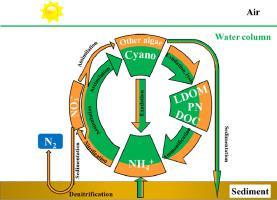Water Research ( IF 11.4 ) Pub Date : 2021-09-30 , DOI: 10.1016/j.watres.2021.117724 Jingya Xue 1 , Xiaolong Yao 2 , Zhonghua Zhao 2 , Chen He 3 , Quan Shi 3 , Lu Zhang 2

|
Algal bloom species can live upon internal regenerated ammonium (NH4+) for growth during the nitrogen-limited period. However, the linkages between NH4+ regeneration and phytoplankton biomass and community composition dynamics remain largely unknown. To unravel the interactions between NH4+ regeneration and phytoplankton community, we measured water column NH4+ regeneration rates (REGs) during a continuous phytoplankton growing period and a contrast summer/winter turnover in eutrophic Lake Taihu. Measured REGs were higher in summer than in winter and significantly correlated to total phytoplankton biomass, Cyanophyta biomass and its biomass proportions, and the concentrations of particulate nitrogen and dissolved organic carbon as well as the relative abundance of labile components (proteins and lipids). Random forest regression analyses displayed that variation of REGs were mainly controlled by water temperature and algal-related parameters (including chlorophyll a, total phytoplankton biomass, and Cyanophyta biomass). Partial least squares path model further revealed that algal-related parameters were the direct and significant factors regulating REGs, and contributed to the largest effect of the variance in REGs. Of the algal community, Cyanophyta was the dominant phylum to accelerate REGs. Correspondingly, rapid internal NH4+ turnover may strongly support the persistence of cyanobacterial blooms, thus forming a positive feedback between cyanobacterial blooms and REGs during the nitrogen-limited summer months. We therefore deduced that the internal loop between cyanobacterial blooms and REGs during summer may be a key self-maintenance mechanism of continuous cyanobacterial blooms.
中文翻译:

内循环维持富营养化湖泊中的蓝藻大量繁殖:来自有机氮和铵再生的证据
在氮限制期间,藻华物种可以依靠内部再生铵 (NH 4 + ) 生长。然而,NH 4 +再生与浮游植物生物量和群落组成动态之间的联系在很大程度上仍然未知。为了阐明 NH 4 +再生与浮游植物群落之间的相互作用,我们测量了水柱 NH 4 +浮游植物连续生长期间的再生率(REGs)和富营养化太湖的夏/冬周转对比。夏季测量的 REG 高于冬季,并且与浮游植物总生物量、蓝藻生物量及其生物量比例、颗粒氮和溶解有机碳的浓度以及不稳定成分(蛋白质和脂质)的相对丰度显着相关。随机森林回归分析表明,REGs 的变化主要受水温和藻类相关参数(包括叶绿素a、总浮游植物生物量和蓝藻生物量)。偏最小二乘路径模型进一步揭示了藻类相关参数是调节REGs的直接和显着因素,并且对REGs方差的影响最大。在藻类群落中,蓝藻是加速 REG 的主要门。相应地,快速的内部NH 4 +周转可能强烈支持蓝藻水华的持续性,从而在氮限制的夏季月份期间蓝藻水华和REG之间形成正反馈。因此,我们推断夏季蓝藻水华与 REG 之间的内部循环可能是蓝藻持续水华的关键自我维持机制。









































 京公网安备 11010802027423号
京公网安备 11010802027423号